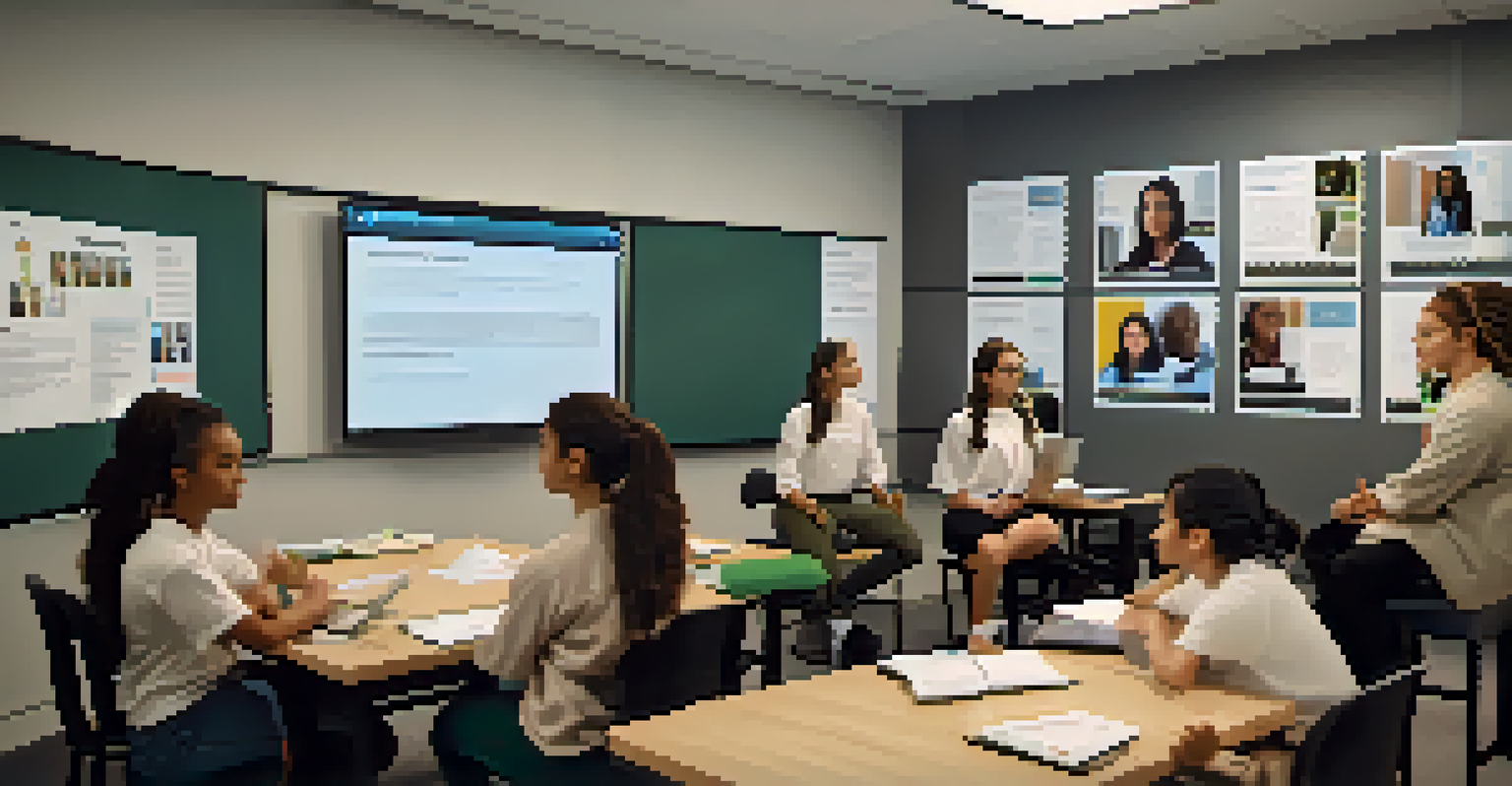Strategies for Managing Conflict in Online Learning Spaces

Understanding Conflict in Online Learning Environments
Conflict in online learning can arise from misunderstandings, differing opinions, or competition among students. When communication is digital, it's easier for tone and intention to get lost, leading to disagreements. Recognizing that these conflicts are common is the first step towards effective management.
The greatest problem in communication is the illusion that it has been accomplished.
Unlike traditional classrooms, online spaces lack non-verbal cues, which can exacerbate issues. For example, a comment meant as constructive criticism might be perceived as harsh or dismissive without the context of body language. This highlights the importance of clarity and empathy in written communication.
By understanding the unique dynamics of online learning, educators and students can better navigate conflicts. Awareness of these factors encourages a proactive approach, focusing on prevention and resolution rather than avoidance.
Establishing Clear Communication Guidelines
Setting clear communication guidelines can significantly reduce misunderstandings in online settings. These guidelines should include expectations for respectful dialogue and prompt responses. When everyone knows the ground rules, it fosters a safe space for sharing ideas and opinions.

For instance, instructors can create a simple code of conduct that outlines acceptable language and behavior in discussions. This can help students feel more comfortable expressing themselves without the fear of backlash or misinterpretation. Regular reminders and reinforcement of these guidelines can also help maintain a positive atmosphere.
Manage Conflict with Clear Guidelines
Establishing clear communication guidelines fosters respectful dialogue and reduces misunderstandings in online learning.
Moreover, encouraging students to ask questions if they're unsure about a message can prevent confusion from escalating into conflict. Open lines of communication are essential in creating a collaborative learning environment and can turn potential conflicts into constructive conversations.
Fostering a Culture of Respect and Inclusivity
A culture of respect and inclusivity can go a long way in managing conflicts in online learning spaces. When students feel valued and included, they are less likely to engage in negative behaviors that lead to disputes. This culture should be nurtured by both educators and peers alike.
Conflict is inevitable, but combat is optional.
One effective way to promote this culture is through icebreakers and team-building activities at the beginning of a course. These activities help students get to know each other, breaking down barriers and fostering relationships. When students see each other as individuals rather than just usernames, it enhances mutual respect.
Additionally, educators should model respectful behavior in their interactions. By demonstrating how to address disagreements constructively, they set an example for students to follow. A respectful environment not only minimizes conflict but also enriches the learning experience.
Encouraging Open Dialogue and Feedback
Encouraging open dialogue and feedback can help identify potential conflicts before they escalate. Creating opportunities for students to voice their concerns and suggestions fosters a sense of ownership in the learning process. This proactive approach can lead to quick resolutions and improved relationships.
For example, regular check-in sessions, either through surveys or discussion boards, allow students to express their feelings about the course dynamics. This feedback can be invaluable in addressing issues that might not be immediately visible to instructors. Being receptive to this feedback shows students that their voices matter.
Promote Inclusivity to Reduce Disputes
Creating a culture of respect and inclusivity helps students feel valued, minimizing the likelihood of conflicts.
Moreover, teaching students how to provide constructive feedback to one another can further enhance communication. Instead of criticism, they can learn to share perspectives that focus on improvement and collaboration, reducing the likelihood of conflict.
Utilizing Conflict Resolution Techniques
When conflicts do arise, utilizing effective conflict resolution techniques is crucial. Techniques such as active listening, mediation, and problem-solving can help de-escalate situations. These strategies encourage students to work together towards a solution rather than against each other.
Active listening involves fully concentrating on what the other person is saying, which can help clarify misunderstandings. This technique allows students to feel heard and respected, often diffusing tension. Similarly, mediation can provide a neutral space for students to discuss their differences with guidance from an instructor.
Problem-solving encourages a collaborative mindset, where students focus on finding solutions rather than assigning blame. For instance, group projects can be an excellent platform for practicing these skills, as students learn to navigate their differences while working towards a common goal.
Incorporating Technology to Manage Conflict
Technology can play a pivotal role in managing conflict in online learning spaces. Tools like discussion forums, chat applications, and video conferencing can facilitate communication and conflict resolution. By leveraging these technologies, students can express themselves in various formats and find common ground more easily.
For example, using video calls can help restore the personal connection that text-based communication often lacks. Seeing facial expressions and hearing tone can clarify intentions, reducing the likelihood of misunderstandings. Additionally, discussion forums allow for asynchronous communication, giving students time to formulate their thoughts before responding.
Leverage Technology for Conflict Resolution
Utilizing technology, such as video calls and discussion forums, enhances communication and aids in resolving conflicts effectively.
Moreover, online platforms often have features that allow for private messaging. This can be a useful tool for students to address issues directly with one another or seek help from instructors without public scrutiny. Embracing technology in conflict management creates a more dynamic and responsive learning environment.
Promoting Emotional Intelligence in Students
Developing emotional intelligence among students can significantly aid in conflict management. Emotional intelligence involves recognizing and managing one's emotions, as well as understanding the emotions of others. By promoting these skills, students can better navigate interpersonal challenges in online learning.
Educators can introduce activities that enhance self-awareness and empathy, such as reflective journaling or group discussions about emotional responses. These exercises encourage students to consider their feelings and how their actions impact others. When students are more attuned to their emotions, they are less likely to react impulsively in conflicts.

Furthermore, integrating emotional intelligence into the curriculum can help students develop critical life skills. As they learn to manage their emotions and respond to others with empathy, they become better equipped to handle conflicts not just in school, but in their personal and professional lives as well.